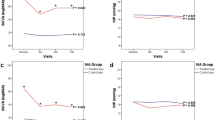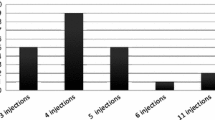Abstract
Purpose
To investigate long-term effect (96 months) of intravitreal ranibizumab administered for exudative age-related macular degeneration (AMD) on retinal nerve fiber layer (RNFL) thickness when used following a pro re nata regimen.
Methods
In this prospective study, 20 eyes of 20 patients diagnosed with exudative AMD were included. Contralateral non-exudative AMD eyes of nine of these patients were included as controls. Data on intraocular pressure (IOP) and number of injections were recorded. Spectralis optic coherence tomography (OCT) of the circumpapillary RNFL was performed under dilation when diagnosis was made and before the three loading injections. “Follow-up” software was selected to accurately compare baseline with subsequent images through the 8 years of the study.
Results
Baseline IOP was 14.1 mmHg both in study (standard deviation, SD: 0.8) and control eyes (SD: 0.9) and remained unchanged during the study. Mean number of injections was 21 (SD: 2.8) at the end of the study. Mean average thickness of RNFL in the study eye group at the end of the study was 96.5 μm (SD: 2.1). Mean loss for the study period was 5.3 μm (SD: 0.7; p < 0.0001). Corresponding RNFL values for controls were 92.9 (SD: 3.2) and 5.8 μm (SD: 1.2; p < 0.001). Superior temporal sector had the greatest loss in both groups, followed by inferior and nasal sectors. No statistically significant differences were found when comparing losses in injected eyes versus control eyes.
Conclusions
RNFL thickness decreased both equally in injected eyes and control eyes. Thus, no long-term effects of intravitreal ranibizumab were observed on the retinal nerve fiber layer thickness.


Similar content being viewed by others

References
Shin HJ, Kim SN, Chung H, Kim TE, Kim HC (2016) Intravitreal anti-vascular endothelial growth factor therapy and retinal nerve fiber layer loss in eyes with age-related macular degeneration: a meta-analysis. Invest Ophthalmol Vis Sci 57:1798–1806
Beck M, Munk MR, Ebneter A, Wolf S, Zinkernagel MS (2016) Retinal ganglion cell layer change in patients treated with anti-vascular endothelial growth factor for Neovascular age-related macular degeneration. Am J Ophthalmol 167:10–17
Jee D, Lee WK (2012) Inhibitory effect of intravitreal injection of bevacizumab on nerve growth factor. Curr Eye Res 37:408–415
Yannuzzi NA, Patel SN, Bhavsar KV, Sugiguchi F, Freund KB (2014) Predictors of sustained intraocular pressure elevation in eyes receiving intravitreal anti-vascular endothelial growth factor therapy. Am J Ophthalmol 158:319–327
Krohne TU, Muether PS, Stratmann NK, Holz FG, Kirchhof B, Meyer CH, Fauser S (2015) Influence of ocular volume and lens status on pharmacokinetics and duration of action of intravitreal vascular endothelial growth factor inhibitors. Retina 35:69–74
Loureiro M, Matos R, Sepulveda P, Meira D (2017) Intravitreal injections of bevacizumab: the impact of needle size in intraocular pressure and pain. J Curr Glaucoma Pract 11:38–41
Soheilian M, Karimi S, Montahae T, Nikkhah H, Mosavi SA (2017) Effects of intravitreal injection of bevacizumab with or without anterior chamber paracentesis on intraocular pressure and peripapillary retinal nerve fiber layerthickness: a prospective study. Graefes Arch Clin Exp Ophthalmol 255:1705–1712
Song S, Yu X-b, Dai H (2016) Effect of prophylactic intraocular pressure-lowering medication (brinzolamide) on intraocular pressure after ranibizumab intravitreal injection: a case–control study. Indian J Ophthalmol 64:762–766
Martínez-de-la-Casa JM, Ruiz-Calvo A, Saenz-Frances F et al (2012) Retinal nerve fiber layer thickness changes in patients with age-related macular degeneration treated with intravi- treal ranibizumab. Invest Ophthalmol Vis Sci 53:6214–6218
Julien S, Biesemeier A, Taubitz T, Schraermeyer U (2014) Different effects of intravitreally injected ranibizumab and aflibercept on retinal and choroidal tissues of monkey eyes. Br J Ophthalmol 98:813–825
Lalwani GA, Rosenfeld PJ, Fung AE, Dubovy SR, Michels S, Feuer W, Davis JL, Flynn HW Jr, Esquiabro M (2009) A variable-dosing regimen with intravitreal ranibizumab for neovascular age-related macular degeneration: year 2 of the PrONTO study. Am J Ophthalmol 148:43–58
Benjamini Y, Hochberg Y (1995) Controlling the false discovery rate: a practical and powerful approach to multiple testing. J Royal Stat Soc B 57:289–300
Manjunath V, Shah H, Fujimoto JG, Duker JS (2011) Analysis of peripapillary atrophy using spectral domain optical coherence tomography. Ophthalmology 118:531–536
(2010) Spectralis HRA+OCT User Guide Software Version 5.3. Heidelberg Engineering GmbH, pp 60–62
Johnson DE, El-Defrawy SR, Almeida DRP, Campbell RJ (2009) Comparison of retinal nerve fibre layer measurements from time domain and spectral domain optical coherence tomography systems. Can J Ophthalmol 44:562–566
Bendschneider D, Tornow RP, Horn FK, Laemmer R, Roessler CW, Juenemann AG, Kruse FE, Mardin CY (2010) Retinal nerve fiber layer thickness in normals measured by spectral domain OCT. J Glaucoma 19:475–482
Hougaard JL, Ostenfeld C, Heijl A, Bengtsson B (2006) Modelling the normal retinal nerve fibre layer thickness as measured by stratus optical coherence tomography. Graefes Arch Clin Exp Ophthalmol 244:1607–1614
Parikh RS, Parikh SR, Sekhar GC, Prabakaran S, Babu JG, Thomas R (2007) Normal age- related decay of retinal nerve fiber layer thickness. Ophthalmology 114:921–926
Hammel N, Belghith A, Weinreb R, Medeiros F, Mendoza N, Zangwill L (2017) Comparing the rates of retinal nerve fiber layer and gnalion cell inner plexiform layer loss in healthy eyes and in glaucoma eyes. Am J Ophthalmol 178:38–50
Sobaci G, Güngor R, Ozge G (2013) Effects of multiple intravitreal antiVEGF injections on retinal nerve fiber layer and intraocular pressure: a comparative clinical study. Int J Ophthalmol 6:211–215
Yang HS, Woo JE, Kim MH, Kim DY, Yoon YH (2017) Co-evaluation of Peripapillary RNFL thickness and retinal thickness in patients with diabetic macular edema: RNFL misinterpretation and its adjustment. PLoS One 12(1):e0170341. https://doi.org/10.1371/journal.pone.0170341
Jo Y-J, Kim W-J, Shin I-H, Kim J-Y (2016) Longitudinal changes in retinal nerve Fiber layer thickness after intravitreal anti-vascular endothelial growth factor therapy. Korean J Ophthalmol 30:114–120
Funding
No funding was received for this research.
Author information
Authors and Affiliations
Corresponding author
Ethics declarations
Conflict of interest
Author Alicia Valverde-Megías declares that she has no conflict of interest. Author Aurora Ruiz-Calvo declares that she has no conflict of interest. Antonio Murciano-Cespedosa declares that he has no conflict of interest. Samuel Hernández-Ruiz declares that he has no conflict of interest. Jose María Martínez-de-la-Casa declares that he has no conflict of interest. Julián García-Feijoo declares that he has no conflict of interest.
No conflicting relationship exists for any author.
Ethical approval
All procedures performed in studies involving human participants were in accordance with the ethical standards of the institutional and/or national research committee and with the 1964 Helsinki declaration and its later amendments or comparable ethical standards.
This article does not contain any studies with animals performed by any of the authors.
Informed consent
Informed consent was obtained from all individual participants included in the study.
Financial support
None.
Additional information
Publisher’s note
Springer Nature remains neutral with regard to jurisdictional claims in published maps and institutional affiliations.
Rights and permissions
About this article
Cite this article
Valverde-Megías, A., Ruiz-Calvo, A., Murciano-Cespedosa, A. et al. Long-term effect of intravitreal ranibizumab therapy on retinal nerve fiber layer in eyes with exudative age-related macular degeneration. Graefes Arch Clin Exp Ophthalmol 257, 1459–1466 (2019). https://doi.org/10.1007/s00417-019-04325-y
Received:
Revised:
Accepted:
Published:
Issue Date:
DOI: https://doi.org/10.1007/s00417-019-04325-y



